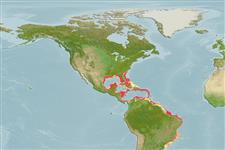Common names from other countries
Environment: milieu / climate zone / depth range / distribution range
Ecologia
marinhas associadas(os) a recifes; intervalo de profundidade 2 - 150 m (Ref. 5222), usually 2 - 35 m (Ref. 40849). Subtropical; 33°N - 28°S, 98°W - 28°W (Ref. 5222)
Western Atlantic: Gulf of Mexico, Bermuda, Caribbean (mainly insular localities), and Brazil.
Tamanho / Peso / Idade
Maturity: Lm ? range ? - ? cm
Max length : 84.0 cm TL macho/indeterminado; (Ref. 40637); common length : 40.0 cm TL macho/indeterminado; (Ref. 5217); peso máx. publicado: 10.2 kg (Ref. 40637); idade máx. registrada: 41 anos (Ref. 36872)
Espinhos dorsais (total) : 11; Raios dorsais (total) : 16 - 18; Espinhos anais: 3; Raios anais : 10 - 12. Distinguished by the following characteristics: Tan to brown above, paler below; upper parts of head and most of body usually have small, brown, close-set spots; sometimes uniformly brown. Adults have exerted rays that are even and about equal in length; 23-27 total gill rakers (Ref. 26938); depth of body 3.0-3.4 times in SL; head length 2.8-3.0 times in SL; angular preopercle, enlarged serrae on prominent lobe at the angle and a distinct notch above the serrate lobe; greatly enlarged posterior nostrils in adults (Ref. 89707).
Found mainly on rocky or coral bottoms from the shoreline to at least 55 m depth; small and middle-sized individuals commonly occur in mangrove-lined lagoons. Feeds on fishes. Sex-reversal observed (Ref. 5521). More common in island waters than along the coast (Ref. 26938). The tricolored pattern of the juveniles mimics that of the juveniles of the clown wrasse, Halichoeres maculipinna. The aggressive mimic’s behavior includes folding down the median and caudal fins, which adds to its wrasse imitation and allows it to approach its otherwise wary prey (Ref. 43465). Marketed fresh; flesh is of good quality.
Ciclo de vida ou comportamento de acasalamento
Maturities | Reprodução | Spawnings | Egg(s) | Fecundities | Larvas
Pelagic spawner (Ref. 32199).
Heemstra, P.C. and J.E. Randall, 1993. FAO Species Catalogue. Vol. 16. Groupers of the world (family Serranidae, subfamily Epinephelinae). An annotated and illustrated catalogue of the grouper, rockcod, hind, coral grouper and lyretail species known to date. Rome: FAO. FAO Fish. Synop. 125(16):382 p. (Ref. 5222)
Status na Lista Vermelha da UICN (Ref. 130435)
CITES (Ref. 128078)
Not Evaluated
Ameaça para os humanos
Harmless
Uso pelos humanos
Pescarias: espécies comerciais; Aquário: Aquários públicos
Ferramentas
Relatórios especiais
Baixar XML
Fontes da internet
Estimates based on models
Preferred temperature (Ref.
115969): 23.3 - 28, mean 26.4 (based on 460 cells).
Índice de diversidade filogenética (Ref.
82804): PD
50 = 0.5000 [Uniqueness, from 0.5 = low to 2.0 = high].
Bayesian length-weight: a=0.00646 (0.00395 - 0.01056), b=3.05 (2.92 - 3.18), in cm Total Length, based on LWR estimates for this species & Genus-body shape (Ref.
93245).
Nível Trófico (Ref.
69278): 4.5 ±0.8 se; based on diet studies.
Resiliência (Ref.
120179): Baixo, tempo mínimo de duplicação da população 4,5 - 14 anos (K=0.06; tmax=41).
Fishing Vulnerability (Ref.
59153): High to very high vulnerability (67 of 100).
